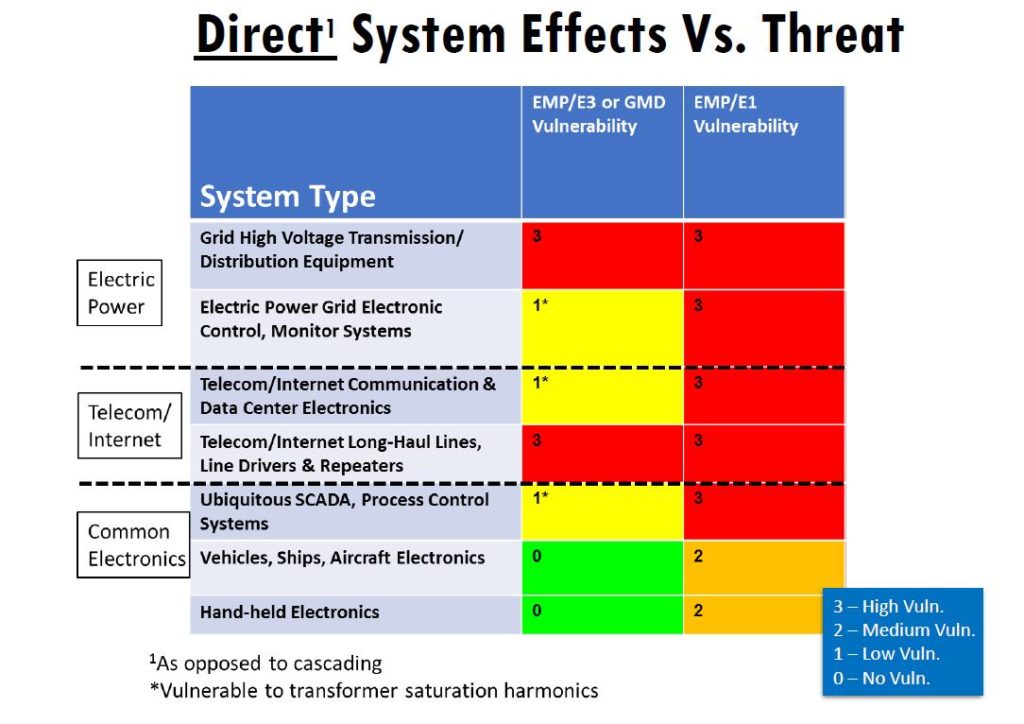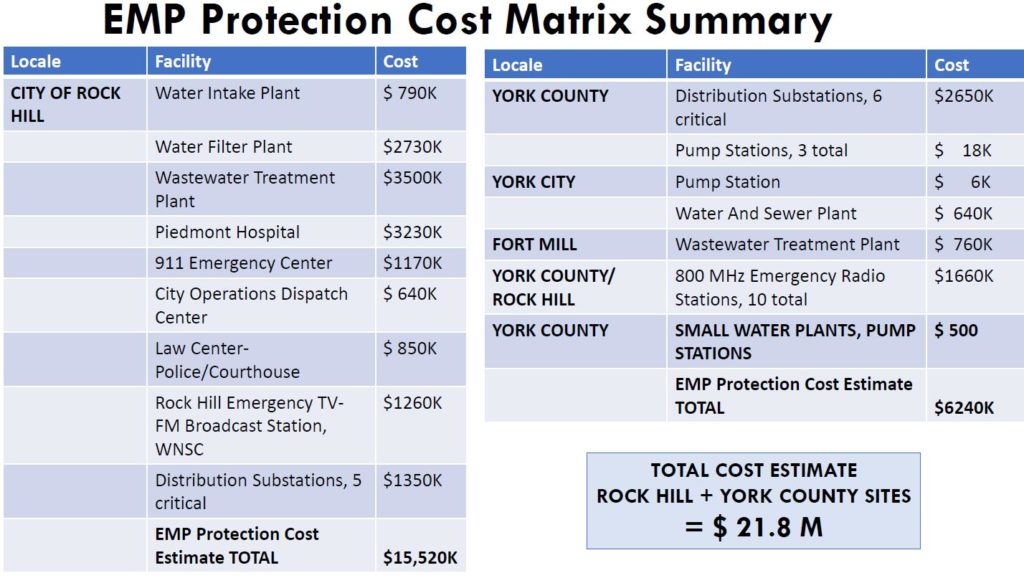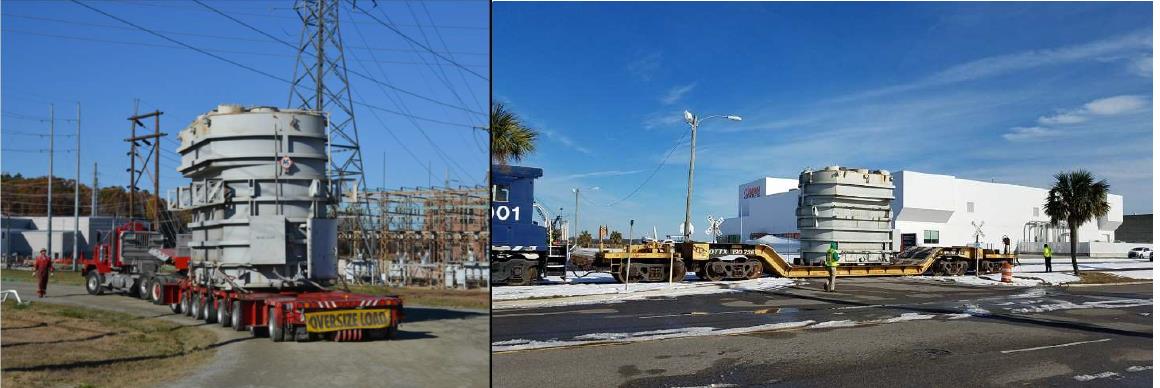“It is way past time to stop admiring this problem, and actually begin to do something concrete to protect our vulnerable electrical grid, control systems, and the ever-increasing array of electronic devices our society has become dependent upon.” ~Senator Ron Johnson (R-WI), Chairman of the Homeland and Governmental Affairs Committee
The Lake Wylie Pilot Study meets Senator Johnson’s demand for a “concrete” initiative to protect our electric power grid. It is the first comprehensive effort to quantify costs for protecting the Distribution Grid against electromagnetic pulse (EMP) threats — both natural and man-made EMP threats. Furthermore, its “defense conservative” assessment and proposed hardening effort would remove uncertainties that have undermined efforts to protect the grid by demonstrating that these costs are quite affordable.
This “defense conservative” effort is well-founded because it employs the same military standard used for decades to protect our most important military systems. When employed in the Lake Wylie Pilot Study, it led to a conclusion that meeting this standard to protect the Rock Hill/York County Distribution Grid would cost less than $100 for each York County citizen. Moreover, there are turn-key contractors who can implement these recommended procedures.
Leaders of the Rock Hill Municipal Utility and York County Co-operative companies opened their infrastructure for, and were most cooperative in, allowing a vulnerability assessment and recommended hardening to assure the viability of the most important critical civil infrastructure of Rock Hill/York County. The Distribution Grid provides all electricity to the citizens and to support the most important functions they need to sustain their ability to survive and prosper, as illustrated below.
In York County, the Rock Hill Municipal Utility and York County Co-op companies own and operate almost all of the York County Distribution Grid (illustrated in green above), and Duke Energy — one of the nation’s largest energy companies, if not the largest energy company, provides electricity from its Bulk Power grid of power plants and transmission lines as illustrated in red and blue above.
Duke engineers have partnered with us from the beginning of the Lake Wylie Pilot Study, indeed they were actively involved in selecting Lake Wylie as a focus of our joint efforts. Duke owns and operates three power plants on Lake Wylie, the Wylie Hydroelectric Power Plant and the Catawba Nuclear Power Plant in York County, SC and the Allen Coal Power Plant in Gaston County, NC. We decided to focus on York County initially and then turn later to Gaston County and Mecklenburg County — home of Charlotte and Duke’s Corporate Headquarters.
Duke Energy leaders are seeking to protect their grid infrastructure against all threats, including EMP — and Duke Energy is reportedly programming to spend some $38 billion over the next several years to improve their grid’s resilience.
Notably, when we began our Lake Wylie Pilot Study, the engineers of Duke Energy, Rock Hill Municipal Utility and York County Co-op companies were not cooperating to assure that all York County citizens would receive electricity. That depends on the York County Distribution Grid being included in the loading conditions against which Duke’s Bulk Power Grid must work in case of a major blackout. One of the first products of the Lake Wyllie Pilot Study was to correct that disconnect.
These activities were in the context of assessing the vulnerability of the Rock Hill/York County Distribution Grid, which was led by Dr. George Baker who worked with us from the outset five years ago when we first charted the course for the Lake Wylie Pilot Study. Dr. Baker has spent most of his professional career working on EMP issues, including in overseeing development of the Military Standards for protecting our most important military systems and their supporting infrastructure. And he has led and overseen the assessment of these systems, that have been conducted for decades.
These military standards are “defense conservative” to build in a “safety factor” in protecting our most important military systems. We should follow the same sense of priority in protecting our most important critical civil infrastructure.
Shown below is Dr. Baker’s sense of the nature of the EMP threat to various components of essentially any electric system, as he briefed it to senior officials in Rock Hill on March 19, 2019. E1 is the very high-frequency component of the EMP from a high-altitude nuclear explosion — it arrives and is gone in nanoseconds and is especially threatening to systems dependent on modern electronics. Vulnerability of the bottom items depends on how various critical components are connected. For example, your cell phone is probably safe if it is not plugged in for charging — if it is that connection is an antenna that will likely render it vulnerable to the E1 threat. This threat is very worrisome, and generally has not been dealt with throughout the grid. E3 is the very low frequency portion of the EMP pulse — which is similar to the Geomagnetic Disturbance created by a Coronal Mass Emission. If the grid is protected from high altitude EMP from a nuclear explosion, then it will be protected from a Geomagnetic Disturbance — but the convers is not the case.
Dr. Baker considered top priority civil infrastructure dependent on electricity from the York County Distribution grid. I agree with him that assuring the viability of water-wastewater infrastructure is next in importance to assuring the viability of infrastructure providing electricity itself. Without water in hospitals, people will begin dying in hours. And while diesel generators provide limited electricity in most cases, they and their fuel depend on electricity being available. Other key system in York County included the communication systems needed to support emergency management—including important communications with emergency management officials in the State Capitol in Columbia. Below is Dr, Baker’s summary cost-estimates totaling about $22 million as briefed to senior Washington officials on March 19, 2019.
This bottom-line estimate in employing the same hardening methods used to protect our most important military systems to protect York County’s critical Distribution Grid infrastructure was less than $100 per citizen of York County. This one-time investment, which is less than what a family pays monthly for its health insurance, would support the most important civil activities of York County — e.g., its hospital and top priority support such as water-wastewater, emergency management, communications to state and national authorities, etc.
- In considering the way forward, we seek funds to validate this cost estimate by actually hardening the Rock Hill/York County Distribution Grid to the same standards as we have applied for decades to protect our most important military systems.
- If proven, that should end the arguments about it being to expensive to protect the grid that are used to spend a lot of money in more studies to figure our how to reduce those “excessive” costs.
- Protecting the electric power grid is clearly affordable — things standing in the way are political and bureaucratic. (More for a future message.)
For this assessment to assure the citizens of Rock Hill/York County receive electricity, the Distribution Grid must receive electricity from Transmission Lines owned and operated by Duke Energy — and Duke engineers have been engaged and partnered with the Lake Wylie Pilot Study since its beginning — and they are very serious about addressing the EMP threat.
To illustrate Duke Energy’s interest — and the difficulties of getting needed support from the Federal establishment, note that over two years ago Duke Energy gave a large transformer worth over $1.25 million to Clemson University and the Savannah River National Laboratory (SRNL) for testing.
Clemson and SRNL paid to have it moved by heavy truck and rail to the Clemson University Restoration Institute (CURI) in North Charleston — where it still sits idle (and deteriorating) two years later, while SRNL waits hopefully for a million dollars from the Department of Energy (DOE) to ship it up the Savannah River to a SRNL site and prepare it for testing. (Moving it by highway is not practical.)
Bear in mind that, while we wait for the Federal Government to respond, we have no full-scale EMP testing data on such large transformers, not built in this country, that are critically important to the viability of the grid.
As noted above, the Distribution Grid provides electricity to America’s citizens, businesses, hospitals, water-wastewater, factories, communications, etc. — and constitutes about 90-percent of the nation’s electric grid. And the Distribution Grid is not included in many Federal Government considerations — including regulatory considerations that are focused on the Bulk Power Grid — the Power Generation Plants and Transmission lines that provide electricity to the the Distribution Grid. Without these transformers, which are not produced in the United States, grid operations will come to a halt.
This reality illustrates at least my frustration with the federal government, also often expressed by Senator Ron Johnson, Chairman of the Senate Homeland Security and Governmental Affairs Committee and Rep. Ralph Norman, who represents the citizens of Rock Hill, York County and several other counties.
Other SC Representatives are also concerned about the EMP threat — including Rep. Jeff Duncan who represents Oconee and Anderson Counties, where Duke Energy engineers and I hope to work to export the Rock Hill/York County lessons-learned to that important area, which includes the 263rd Army Air and Missile Defense Command, commanded by an Army National Guard Major General who reports directly to the commanders of Army North on Ft. Sam Houston in San Antonio, Texas; First Air Force on Tyndall AFB in Panama City, Florida; and Northern Command in Colorado Springs. South Carolina’s Adjutant General is on-board with this approach to exporting the Rock Hill/York County lessons-learned to protect the national grid.
In South Carolina, we have a microcosm of the national electric power grid in that there are three main “Bulk Power Grid” sources of electricity — Duke Energy, Dominion Energy and Santee-Cooper companies — and about 40 Municipal Utility and Electric Cooperative (Co-op) companies that, in addition to Duke Energy, Dominion Energy and Santee-Cooper, manage much of the SC Distribution Grid. Lessons-learned in effectively integrating these complexities from the Lake Wylie Pilot Study are of broad interest across South Carolina, and ultimately throughout the nation — as we collectively seek to protect the national grid against the full spectrum of threats, particularly existential natural and man-made electromagnetic pulse (EMP) threats.
The left of the below illustration shows the “quilt” of tens of counties across North and South Carolina and Georgia. In green are the three counties most closely involved in our near-term Lake Wylie Pilot Study Plans. Mecklenburg and Gaston Counties in North Carolina and York County in South Carolina surround Duke Energy’s corporate headquarters in Charlotte, NC — the center of the 22nd most populous U.S. metropolitan area. These three counties are served by a Distribution Grid that receives its electricity from Duke’s Bulk Power Grid.
 We agreed with Duke engineers to focus initially on York County, home of two of its important power generation plants. We plan to extend the lessons-learned to the two neighboring NC counties and to four indicated SC counties, with a top priority associated with key related national security missions. We focused early on Rock Hill, a major Charlotte suburb and the fourth largest city in South Carolina — and served by the Rock Hill Utility Company, a member of the Piedmont Municipal Power Association (PMPA) and the South Carolina Association of Municipal Power (SCAMP). The rest of York County is served by the York County Co-operative (co-op) company, which is led by a member of the Electric Cooperatives of South Carolina (ESSC). These professional organizations include about 40 members throughout the 46 counties of South Carolina and can help the leaders of Rock Hill/York County export the lessons-learned from the Lake Wylie Pilot Study.
We agreed with Duke engineers to focus initially on York County, home of two of its important power generation plants. We plan to extend the lessons-learned to the two neighboring NC counties and to four indicated SC counties, with a top priority associated with key related national security missions. We focused early on Rock Hill, a major Charlotte suburb and the fourth largest city in South Carolina — and served by the Rock Hill Utility Company, a member of the Piedmont Municipal Power Association (PMPA) and the South Carolina Association of Municipal Power (SCAMP). The rest of York County is served by the York County Co-operative (co-op) company, which is led by a member of the Electric Cooperatives of South Carolina (ESSC). These professional organizations include about 40 members throughout the 46 counties of South Carolina and can help the leaders of Rock Hill/York County export the lessons-learned from the Lake Wylie Pilot Study.
As noted above, these individuals have provided great support to our efforts to assess the viability of York County’s Distribution Grid, especially in confronting the existential electromagnetic pulse (EMP) threat, which I have discussed extensively over the past five or more years. Dr. Baker’s careful assessment and estimates of the cost of hardening their critical Distribution Grid infrastructure is a benchmark that should be drawn upon throughout South Carolina and beyond. I expect these Rock Hill/York County leaders will help in what is the essence of the “Bottom-Up” approach we have taken thus far.
Getting on with implementing that game plan should be a “no-brainer” for the “powers that be” — if only the “powers that be” can figure out how to provide the needed funds. A challenge for our elected leaders.
The center section of the above chart indicates the Congressional Representatives of the citizens of the Districts that I hope will lead this propagation of lessons-learned and in getting needed funding to protect the Distribution Grid of South Carolina. I believe they and their staffs will be supportive of our efforts. Moreover, our efforts have also set the stage for extending our lessons-learned into North Carolina and beyond.
I expect continued cooperation of the managers and engineers of Rock Hill Municipal Utility, York Electric Co-op and Duke Energy, to complete a meaningful “bottom-up” program to assure the viability of the three Duke Energy power plants on Lake Wylie — and of course associated key Transmission and Distribution infrastructure connecting those power plants and others to their customers.
Bottom Lines.
Dr. Baker’s March 19, 2019 conclusions included that:
- A major impediment to national infrastructure EMP protection has been cost uncertainties. The Lake Wylie Pilot Study is the first comprehensive study to quantify costs. That effort would not have been possible without approval and assistance from local and state public officials and system engineers.
- We have applied the DoD’s low risk approach hardening approach embodied in the Military Standard (MIL-STD-188-125) developed long ago and applied to protect our most important military systems — in an approach that is scalable and portable to other locals.
- Based on costs of prior EMP protection projects, hardening of minimum essential infrasgtructuers in Rock Hill and York County would cost $22 million. Turn-key contractors exist to implement this EMP protection on complete facilities.
We seek $30 million to validate Dr. Baker’s cost estimates by actually hardening the Rock Hill/York County Distribution Grid; and also to provide sufficient additional funds to make specific plans to develop an executable follow-on plan to take the lessons-learned throughout SC and NC and throughout the nation — along with validated cost estimates for executing a national program.
Such funding could be provided via anticipated appropriations that emphasize needed improvements to the nation’s infrastructure, especially in this case to improve the nation’s current electric power grid that is vulnerable to an existential EMP threat.
Our follow-on plan includes a key leading role for the National Guard and particularly its Civil Support Teams in every state. South Carolina’s Adjutant General is supportive of this approach, which fits with missions of the SC National Guard that are already integrated within the key activities throughout the Nation, as led by the NORTHCOM Commander. Consequently, primary funding should be authorized and appropriated via DoD missions, via the existing authorities of Chief of the National Guard.
This approach would be responsive to Senator Ron Johnson’s challenge that:
“It is way past time to stop admiring this problem, and actually begin to do something concrete to protect our vulnerable electrical grid, control systems, and the ever-increasing array of electronic devices our society has become dependent upon.”
What can you do?
Join us in praying for our nation, and for a rebirth of the freedom sought, achieved and passed to us by those who came before us.
Help us to spread our message to the grass roots and to encourage all “powers that be” to provide for the common defense as they are sworn to do.
Begin by passing this message to your friends and suggest they visit our webpage www.highfrontier.org, for more information. Also, please encourage your sphere of influence to sign up for our weekly e-newsletter.
Encourage them to review our past email messages, posted on www.highfrontier.org, to learn about many details related to the existential man-made and natural EMP threats and how we can protect America against them. I hope you will help us with our urgently needed efforts, which I will be discussing in future messages.
Click here to make a tax deductible gift. If you prefer to mail a check, Please send it High Frontier, 20 F Street 7th Floor, Washington, DC 20001.
E-Mail Message 200619
Please click here to read Past Weekly Updates!
Please help High Frontier continue this important and timely work!
Be sure to follow us on our Social Sites!
If you found this letter via our Social Sites, and you would like to subscribe, please click below!









